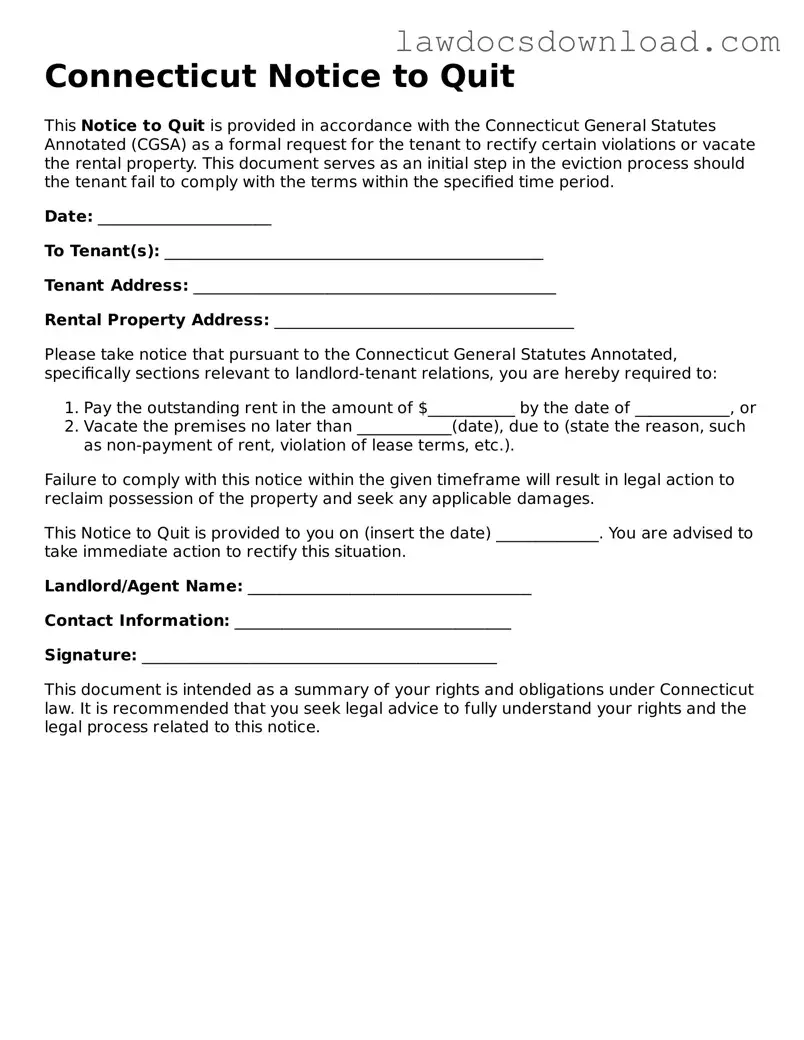The Connecticut Notice to Quit form shares similarities with the Eviction Notice in other states, which serves as an initial step in the eviction process. This notice alerts tenants that they must vacate the premises within a specified period due to reasons such as rent arrears, breach of lease terms, or other violations. The underlying principle is to provide a legal pathway for landlords to reclaim their property while ensuring tenants are adequately informed and given time to rectify the situation or leave the property.
Comparable to the Lease Termination Letter, the Connecticut Notice to Quit informs one party of the intention to end the lease agreement. While the Lease Termination Letter can be initiated by either the landlord or the tenant for various reasons, including the end of a lease term or a mutual agreement to part ways, the Notice to Quit is typically a unilateral action by the landlord due to a breach of the lease conditions by the tenant.
The 30-Day Notice to Vacate is another document resembling the Connecticut Notice to Quit, primarily in its function to advise tenants of the requirement to leave the rental unit. Although the context may differ — with the 30-Day Notice often used for ending a month-to-month rental agreement without cause — the purpose is to ensure tenants have adequate time to find alternate housing, similar to the Notice to Quit's role in the eviction process.
The Cure or Quit Notice closely aligns with the Connecticut Notice to Quit when violations of lease terms are involved, except it provides an option for the tenant to remedy the violation within a certain timeframe to avoid eviction. This document is employed when there is a possibility to correct the issue, such as unpaid rent or unauthorized occupants, emphasizing the tenant's right to "cure" the problem as an alternative to vacating the property.
The Rent Demand Letter, while not a formal eviction notice, is akin to the Connecticut Notice to Quit as it typically precedes it in the eviction process. This letter demands payment of overdue rent and signals the landlord's intention to pursue legal eviction if the rent is not paid by a certain date. It is a critical step in documenting the landlord's attempt to resolve the issue before escalating to a Notice to Quit.
Similar to the Notice to Quit, the Unconditional Quit Notice demands that tenants leave the property without the opportunity to fix the violation. This type of notice is issued for serious breaches, including illegal activities or repeated violations. Both documents share the purpose of compelling tenant compliance under threat of legal eviction, albeit the Unconditional Quit Notice is used in more severe circumstances.
The Sublease Agreement is indirectly related to the Connecticut Notice to Quit, as it involves the agreement between the original tenant and a new tenant to occupy the premises for a portion of the lease term. While a sublease agreement facilitates a new tenant relationship, violating its terms could lead to a Notice to Quit, making both documents part of the broader spectrum of lease management and enforcement.
The Security Deposit Return Letter, though not a notice of lease violation or termination, connects with the aftermath of a Notice to Quit by detailing the conditions under which the security deposit may be returned to the tenant. Following an eviction, this letter itemizes any deductions made from the deposit for unpaid rent, damages, or other lease violations, thus concluding the tenant-landlord financial transactions post-eviction.
The Property Inspection Report, while primarily a tool for documenting the state of a rental property at move-in and move-out, plays a complementary role to the Notice to Quit process. It provides evidence of the condition of the property that may justify the issuance of a Notice to Quit due to damage or neglect by the tenant. Accurate and detailed inspection reports can be critical in eviction proceedings to support the landlord's claims against the tenant.
The Tenancy At Will Agreement, though fundamentally a document establishing a landlord-tenant relationship without a fixed end date, intersects with the Connecticut Notice to Quit concerning termination. Either party can end the tenancy at will with proper notice, often mirroring the Notice to Quit's function of signaling the end of occupancy. However, unlike the more formal lease agreements, a tenancy at will offers flexibility for both parties to make quick changes in living arrangements.
